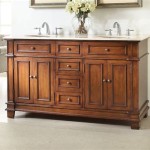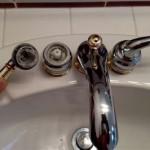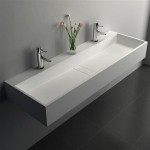Labor Cost to Replace Bathroom Vanity Faucets: A Comprehensive Guide
Replacing bathroom vanity faucets is a common home improvement task that can significantly enhance the aesthetic appeal and functionality of a bathroom. While the project itself might seem straightforward, understanding the associated labor costs is crucial for budgeting and ensuring a smooth installation process. This article provides a detailed overview of the factors influencing the labor cost of replacing bathroom vanity faucets, offering insights into what homeowners can expect to pay and how to potentially manage these expenses.
The labor cost to replace bathroom vanity faucets can vary widely depending on several factors, including the complexity of the installation, the type of faucet being installed, the geographic location, and the plumber's or handyman's experience and hourly rate. Generally, the cost range can fall anywhere from $150 to $500 or more. This price range primarily covers the professional's time and expertise in removing the old faucet, preparing the area for the new one, installing the new faucet correctly, and ensuring proper functionality. It is important to note that this range typically excludes the cost of the faucet itself.
Several elements contribute to the overall labor cost. These include the time required for the project, which can depend on the ease of access to the plumbing connections and the need for any modifications or repairs. The type of faucet (e.g., single-hole, center-set, widespread) also influences the complexity of the installation, as some faucets require more intricate plumbing connections or additional parts. Furthermore, regional differences in labor rates significantly impact the overall cost. Metropolitan areas tend to have higher labor rates compared to rural areas due to a higher cost of living and greater demand for skilled professionals.
Factors Influencing Labor Costs
Several key factors directly influence the labor costs associated with replacing bathroom vanity faucets. Understanding these factors can help homeowners better estimate the potential expenses and plan accordingly.
1. Complexity of the Installation: The complexity of the installation is a primary driver of labor costs. A straightforward replacement involving an identical faucet type in an easily accessible location will typically incur lower labor costs. However, if the existing plumbing is old or corroded, or if the new faucet requires modifications to the plumbing connections or the vanity itself, the labor costs will increase. For example, if the existing shut-off valves are faulty and need replacement, this will add to the overall time and cost of the project. Similarly, if the homeowner is switching from a two-handle faucet to a single-handle faucet that requires drilling a new hole in the vanity, the additional labor required for this modification will increase the overall cost.
2. Type of Faucet: The type of faucet being installed also plays a significant role in determining labor costs. Simple single-hole faucets are generally the easiest and quickest to install, resulting in lower labor costs. Center-set faucets, which typically have a spout and two handles mounted on a base, are also relatively straightforward. Widespread faucets, on the other hand, are more complex as they involve separate spout and handle components, requiring more intricate plumbing connections and potentially more time to install. Wall-mounted faucets often require the most extensive modifications and plumbing work, leading to the highest labor costs. The complexity stems from the need to run plumbing lines within the wall and ensure a secure and watertight connection.
3. Condition of Existing Plumbing: The condition of the existing plumbing beneath the vanity significantly impacts the labor cost. If the existing pipes and shut-off valves are corroded, damaged, or difficult to access, the plumber may need to spend extra time and effort to remove them without causing further damage. In some cases, the plumber may recommend replacing the old plumbing with new materials, which will add to the overall cost of the project. This is especially common in older homes where the plumbing may be outdated or made of less durable materials. Older pipes are also more prone to leaks and breaks, requiring additional time and care during the replacement process.
Typical Cost Breakdown
To better understand the labor cost associated with replacing bathroom vanity faucets, it is helpful to break down the typical expenses involved. This breakdown provides a clearer picture of where the money is being spent and helps homeowners make informed decisions.
1. Plumber or Handyman’s Hourly Rate: The hourly rate of the plumber or handyman is a fundamental factor in determining the overall labor cost. Hourly rates can vary significantly depending on the geographic location, the professional's experience, and the level of expertise. Highly experienced plumbers in metropolitan areas typically charge higher hourly rates compared to less experienced handymen in rural areas. It is essential to obtain quotes from multiple professionals to compare their hourly rates and ensure that the quoted rate is reasonable and competitive. Generally, licensed plumbers will have higher hourly rates than general handymen because they have invested time and money into training and licensing procedures.
2. Removal of Old Faucet: The labor involved in removing the old faucet is a component of the project's overall cost. This process can range from being relatively simple and straightforward to being challenging and time-consuming, depending on how easily the old faucet's connections can be accessed and disconnected. The complexities increase if the old faucet is corroded or if the nuts and bolts are seized. This may necessitate the use of specialized tools and techniques to safely remove the old faucet without damaging the vanity or plumbing. The time spent on removing the old faucet can directly impact the overall labor cost.
3. Installation of New Faucet: The installation of the new faucet is the core of the project and a substantial portion of the labor cost. This includes connecting the faucet to the water supply lines, ensuring that all connections are watertight, and properly securing the faucet to the vanity. The complexity of the installation will depend on the type of faucet being installed and the existing plumbing configuration. Some faucets may require additional parts or modifications to the plumbing, which will add to the labor cost. Proper installation is crucial to prevent leaks and ensure the faucet functions correctly for years to come.
4. Testing and Adjustments: After the new faucet is installed, the plumber or handyman will typically test the faucet to ensure it is functioning properly and that there are no leaks. This involves running water through the faucet and checking all connections for any signs of leaks. Adjustments may be necessary to ensure the faucet operates smoothly and efficiently. This step is essential to guarantee the longevity and optimal performance of the new faucet. Small leaks can cause severe water damage over time, so it is crucial to address them immediately.
Tips for Managing Labor Costs
While the labor cost to replace bathroom vanity faucets can be significant, there are several strategies that homeowners can employ to manage these expenses and potentially save money.
1. Obtain Multiple Quotes: One of the best ways to manage labor costs is to obtain quotes from multiple plumbers or handymen before committing to a specific professional. This allows homeowners to compare prices and services and choose the option that best fits their budget and needs. It is recommended to obtain at least three quotes to get a clear understanding of the prevailing market rates in the area. When comparing quotes, be sure to ask each professional for a detailed breakdown of the estimated costs, including hourly rates, material costs, and any potential additional fees.
2. Choose the Right Faucet: Selecting the right type of faucet can also help manage labor costs. As previously mentioned, simple single-hole faucets are typically the easiest and quickest to install, resulting in lower labor costs. If the existing plumbing is in good condition and the homeowner is simply replacing an old faucet with a similar model, the installation will likely be more straightforward and less expensive. Avoid selecting a complex or unconventional faucet that may require extensive modifications to the plumbing or vanity.
3. Prepare the Area: Homeowners can also help reduce labor costs by preparing the area before the plumber or handyman arrives. This might involve clearing the area beneath the vanity, removing any personal items, and providing easy access to the plumbing connections. The professional can begin work immediately when fewer obstacles are present, saving time and labor costs. Additionally, ensure adequate lighting in the work area to allow the plumber to see clearly and complete the job efficiently.
4. Consider DIY (If Qualified): For homeowners with experience in plumbing and home improvement projects, replacing a bathroom vanity faucet may be a viable DIY project. By tackling the project themselves, homeowners can save on labor costs. However, it is essential to carefully assess one's skills and experience before attempting a DIY installation. If the homeowner is not comfortable working with plumbing or if the project involves complex modifications, it is best to hire a qualified professional to avoid potential problems. Incorrect installation can lead to leaks, water damage, or even more costly repairs in the future.
In summary, the labor cost to replace bathroom vanity faucets involves numerous factors that must be taken into account for accurate budgeting. By understanding the primary influences, homeowners can make more informed decisions and potentially manage costs effectively. Proper planning, diligent research, and careful consideration of project complexity will result in a satisfactory outcome.

How Much Does It Cost To Replace A Bathroom Faucet Angi

Cost To Replace Bathroom Vanity Evaluating Expenses

Cost To Replace Bathroom Vanity Evaluating Expenses

Bathroom Sink Cost To Replace Fixr

Faucet Costs In Atlanta How Much Should You Expect To Spend Ranney Blair Weidmann

Cost To Replace Bathroom Vanity Evaluating Expenses

Cost To Install A Faucet The Home Depot

How Much Does It Cost To Install A Bathroom Faucet 2025

How Much Does It Cost To Replace A Kitchen Faucet Ranshaw
2025 Average Sink Or Faucet Repair Cost With Factors
Related Posts







